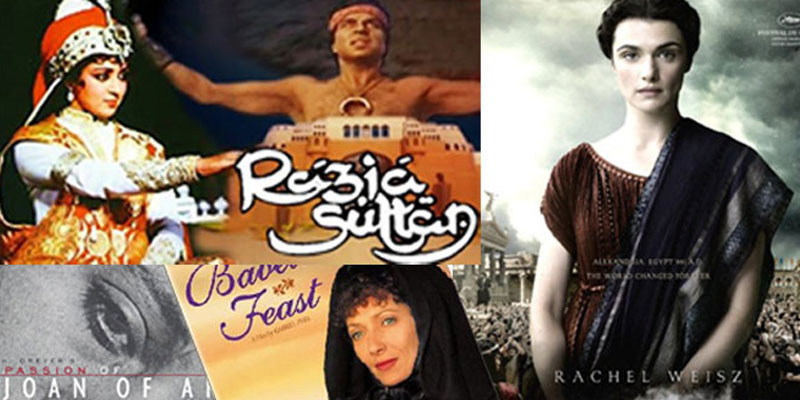
Be it Hollywood, Bollywood or any other film industry, you will rarely come across a movie that presents a strong woman as a protagonist. Yet there have been significant movies that focus on women characters specifically — both fictional and historical. You will find most of these women struggling against social norms, becoming victims of violence — both physical and mental; some of these women become successful in their fight and the rest succumb to pressure exerted upon them not only by the society at large, but also by their dear ones.
The best known characters have been avoided in this article such as Anna Karenina, Madame Bovary, or Queen Elizabeth, about whom many movies have been made — and talking about them has become almost a cliché.
The Chilean-born director Alejandro Amenbar’s widely acclaimed historical drama Agora is a telling portrait of religious fascism and misogyny. Hypatia, the protagonist, is considered the first woman mathematician, astronomer, and philosopher about whom historical record still exists. At the dawn of the fifth century AD, she is reported to have been heading the Neoplatonic School at Alexandria in Egypt, then a part of the Eastern Roman Empire.
Rachel Weisz gives a moving performance as Hypatia, the scientist who loves reading, research, and teaching; she derives pleasure from studying heavenly bodies and discusses Ptolemy’s model of planetary motion. She indulges in philosophical questions at the library of Alexandria while the city is on the verge of being taken over by the newly-empowered Christian zealots.
Hypatia is neither a pagan nor a believer in a Christian god; she is a skeptic who questions everything. Hypatia is in the library when the Christian mob imposes a siege around the library; the Romans find themselves outnumbered and the ruler declares that the Christians shall be allowed to enter the library and do with it what they please. Hypatia tries to save the most important scrolls before the Christians overtake the library and destroy its contents while Roman soldiers silently witness the destruction.
Finally, Hypatia is murdered by the mob. The age of reason comes to an end due to the waves of religious barbarity and obscurantism.
Razia Sultan is one of the most interesting Muslim women in the history of India. In the 13thcentury it was unthinkable that a woman would rule over India and prove herself to be a match to her male adversaries. When Kamal Amrohvi (1918 – 1993) took up the challenge of putting Razia Sultan on screen he did not realise that the project would take him almost a decade to complete. Proud of the success of Pakeeza (1972), he selected the dream girl of Indian cinema, Hema Malini, to play the enviable role of Razia; and by all means Hema did a great job at it.
Hema Malini as Razia embodies the spirit of defiance and suppresses her opponents with the help of her former slave and now general Yakut (Dharmendra). Though the history of her love with her former African slave is disputed, in the film it is beautifully handled; who can forget Lata’s melodious Aye dil-e-naadaan and Jalta hay badan.
Razia is portrayed as a secular ruler concerned for the welfare of her people irrespective of their cast and creed; the message she delivers is of harmony among her subjects. In the film, Hema emerges as a towering personality — head and shoulders above her peers. It must have been a daunting task for a south Indian girl to play a north Indian queen and deliver lines in an Urdu that has more Arabic and Persian words than the Urdu of today.
The film failed on the box office — perhaps due to its slow pace and difficult dialogues — but it remains a masterpiece of Indian cinema.
The Passion of Joan of Arc was one of the last silent movies that were made in Europe before the talkies took over. Joan of Arc is a historical figure of the 15th century France that was fighting against English domination during the 100-Year War.
Joan was able to mobilise the French who were losing strength to fight the invaders. At just 19 years of age, she was burnt at stake for charges of heresy and cross-dressing. She used religion to give credence to her claims against the enemy forces and said that she had had visions of angels commanding her to fight to defend the French.
The film is considered a landmark in the history of film-making and used as teaching material in film studies courses.
Renée Jeanne Falconetti never appeared in any other film after this, but she remains an icon due to her sorrowful face throughout the movie — close-up shots of her face as well as those of her tormentors’ were used to recreate the passion of the events. You should watch this movie only if you are interested in European history of medieval period or you are a student of cinema who has an eye for the technicalities of 1920s cinema.
If you have seen The Discreet Charm of the Bourgeoisie (Luis Bunuel, 1972) and Out of Africa (Sydney Pollack, 1985), you will recall Stephane Audran and Karen Blixen. Stephane Audran is a French actress who played a role in Luis Bunuel’s notorious flick, and Karen Blixen is a Danish writer who wrote Out of Africa and Babette’s Feast.
Babette’s Feast is the story of a French chef, Babette, who leaves a luxurious life in 19thcentury France to escape repeated revolutions and wars and seeks refuge in a Danish village with two sisters in return for her services as their maid.
Babette is neither a fighter nor a philosopher, she is a woman who makes an extremely unlikely decision to spend the entire lottery money that she wins to make the villagers happy. Those familiar with the nuances of European regional differences will not miss the contrast between an austere protestant way of life and the lavish manner of catholic aristocracy.
Lukshmibai, the Rani of Jhansi, was just 30 years old when she died fighting valiantly the forces of the British Raj in India in 1858. Sohrab Modi (1897–1984 — no relation with Narendra Modi) selected his wife, Mehtab, to play the protagonist in the historical epic. Modi of Minerva Movietone was a master of Indian drama and had made a trilogy of historical spectaculars — Pukar (1939), Sikandar (1941), and Prithvi Vallabh (1943). For Jhansi Ki Rani, he went a step further and utilised Hollywood talent to make it the first Indian movie in technicolor.
Like Razia Sultan and Joan of Arc, Jhansi ki Rani became a symbol of courage by giving a fierce resistance to the British forces and was a major figure in the War of Independence (1857–58). Mehtab gave a stellar performance as the Rani and proved that her husband’s confidence in her was not misplaced.
Sadly, for Modi, the film was a financial disaster despite its high quality production. If you have read in Pakistan textbooks — like all of us did — that it was only Muslim League that fought for independence; and if you are interested in a neglected chapter of Indian history or if you are a fan of Mehtab or Modi, the film will be a delight to watch.
Courtesy: TNS (The News on Sunday)







